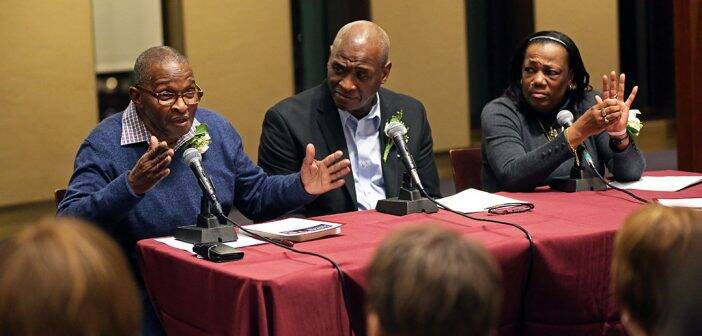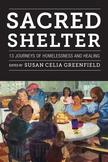How can we solve homelessness? Listen to the people who have experienced it.
You are walking down the street. A homeless person, ragged and with a sagging expression, holds out his dirty, cupped hand to you. Do you give him a dollar? Whether you do or not, you are likely to wonder how he or she got that way and ponder what good a dollar will do. In either case, you have briefly connected, however unwillingly, with another human being who represents perhaps the major urban issue of our time. New York City has some 70,000 homeless. All but several thousand have been shunted off into temporary shelters or safe havens, so they are not visible beggars on the street, yet they have no bed, bureau or bathroom to call their own. Consider this: At least one out of every 100 of your fellow citizens is in this predicament.
Empire State Editions of Fordham University Press. 336p $30
Of course, it could be worse. There were more people actually sleeping in the streets in the 1970s and 1980s before the city was pressured into building additional shelters and affordable housing. And the shelters and flophouses that existed then were often frightening places. Today, the city spends billions annually to try to ensure that the homeless are adequately cared for. But it is never enough. Each year the numbers of homeless increase.
So how does one help individuals out of homelessness? There are structural means—economic, social and political—that must be improved, certainly. Better and more decent affordable housing, more jobs and improved social services all must be promoted. But these are goals that the city has been grappling with for the last 30 years. The Bloomberg administration even went so far as to pledge that it would eliminate homelessness through a program of rent subsidies and other reforms. (It failed; its policies ended up making the availability of rent subsidies much worse than before.) The progressive De Blasio administration has made no such rash promise, recognizing the complexities of a situation in which every homeless individual, family and child has a right under the New York State Constitution to shelter; every temporarily sheltered person has a need to find permanent housing; and every landlord has a need to find a fair return on his or her real estate.
The testimonies in Susan Celia Greenfield’s Sacred Shelter: Thirteen Journeys of Homelessness and Healing end as tales of redemption for 13 people who have moved out of pits of hopelessness into lasting commitments of love, gratitude and service to others.
The testimonies in Susan Celia Greenfield’s Sacred Shelter: Thirteen Journeys of Homelessness and Healing suggest there may be another important way to approach the alleviation of homelessness, by encouraging the growth of “life skills empowerment” programs such as have been initiated by faith-based organizations in New York City in the past 30 years. This book will not give statistical insights, but it does provide success stories. It contains true-life narratives told by 13 formerly homeless individuals who have turned their lives around through participating in one of these programs, along with the reflections of a dozen individuals who have helped organize and run them. These are accounts of abandonments, molestations, knifings, robbery, beatings, rape, prostitution, slander and addictions that were precursors of homelessness. Yet they end as tales of redemption for 13 people who have moved out of pits of hopelessness into lasting commitments of love, gratitude and service to others.
Among the stories presented here is the gripping downhill tale of Rodney Allen, who, after losing his daughter, wife and job to addiction, simply gave up. When he no longer could make the rent and found the locks changed on his Queens residence, he simply took the R train to Madison Square Park and stayed. “For months I sat in Madison Square Park. I sat on different benches. On Twenty-Third Street and First Avenue you could take a shower twice a week. But everything else I did in the park. I ate soup from the Coalition for the Homeless. The people from Midnight Run brought food and clothes.... I didn’t venture out of the park.... I became glued there.” Until, that is, he was coaxed into entering a recovery program at All Angels’ Church on the Upper West Side and eventually was reunited with his daughter.
There is the story of James Addison, whose discovery as a young man of his mother lying in the courtyard in a pool of blood, a death by suicide, propelled his descent into a life of drugs, petty theft and a homeless shelter. Today, he is an inspiring leader in an East Harlem program, having confronted his past, made amends, graduated from a life skills program and been ordained a minister.
There is the story of Edna Humphrey, raped many times as a teenager by her mother’s boyfriend and in shelters for 14 years. “In the life skills workshops I learned how to budget my money.... I graduated in 2005 and told my story at the ceremony. Afterward, a lady came up and said, ‘You made it through all that? I don’t know how you could make it, but you did.’” Today, she is engaged in a range of volunteer activities. “I love doing things to help people,” she finishes.
Deborah Canty was similarly abused at 10 years old. Today, Deborah is another leader in the East Harlem program with James Addison. Then there is Michelle Riddle, whose father’s illness undid her to the point of turning to prostitution. Today, she is a great-grandmother who proudly ends her life story of hardships with a paean of gratitude to God for the good things that have been done for her.
These are stories of great pathos that the editor, Susan Celia Greenfield, a professor of English at Fordham University, has carefully curated and shaped for clarity and effect, always with the storyteller’s sanction. All of the narrators bear witness to the value of the “life skills empowerment” approach. In the introduction, Greenfield provides a succinct summary of how this approach was conceived and developed by religious leaders in the 1980s, in the aftermath of extended City Hall protests and sit-ins.
If anyone has come to doubt that God is at work in the trenches of the poor, that redemption is possible for anyone, here is a book to refresh their convictions.
Marc Greenberg of the Interfaith Assembly on Homelessness and Housing and George Horton of New York Catholic Charities were among the first to begin planning its curriculum. Both have stories in the book. The programs, according to Greenfield, usually involve a 12-week curriculum and include individual mentors, workshops on healthy living and social justice, counseling on how to get housing and techniques for restoring confidence and working on personal goals. One of the main components of the program involves every participant sharing a version of his or her life story.
I myself have witnessed the power of these programs, if only tangentially. As an Ignatian volunteer, I attended some sessions of an East Harlem program that began somewhat earlier than the life skills programs. It uses similar techniques but does not have a formal curriculum. It calls itself “Life Experience and Faith Sharing Associates” (LEFSA). It is now informally affiliated with other “life skills empowerment” programs and is sponsored by the Sisters of Charity of New York. The weekly meetings I took part in were attended by 40 to 50 homeless individuals. They had both a spiritual and a personal empowerment context. Following prayers and singing, there was typically some discussion of a religious reading. There would then ensue an often vigorous discussion of a life skill such as “self-discipline” or “perseverance” (usually self-selected by the group at a previous meeting). Each participant would then be asked to name an attribute that is particularly striking to him or her, like patience or fortitude.
Every time I participated, I was impressed by how motivated and enthusiastic participants became. LEFSA also replicates these meetings for clients in some of the city’s shelters. It has hundreds of graduates who meet in monthly reunions as well as in Christmas and summer celebrations to reconnect with the program. I observed that LEFSA is very popular and effective in motivating clients to begin more formal life skills training, as well as helping many to navigate the hurdles of the affordable housing bureaucracy. All of its leaders are formerly homeless persons, and they include two featured in this book: James Addison and Deborah Canty.
If anyone has come to doubt that God is at work in the trenches of the poor, that redemption is possible for anyone, here is a book to refresh their convictions. Hopefully, this book may also serve to inspire the creation of more programs like these life skills empowerment programs.











